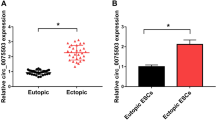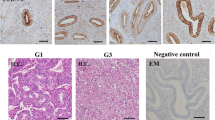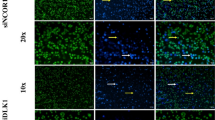Abstract
Cell membrane ion channels have important roles in cell migration during cancer development and metastasis. Although endometriosis is a benign gynecological disease, some migration and invasion characteristics of endometriosis are similar to those of cancer. However, only a few studies have examined cell membrane ion channels and their associations with endometriosis. This study aimed to investigate the effects of these ion channels on development of endometriosis. A total of 39 women who underwent laparoscopic ovarian cyst enucleation were included in the study population. Eutopic endometrium or ectopic endometrium tissues were obtained from each patient based on allocation to an endometriosis group (n=21) or a control group (n=18). Quantitative real-time PCR (qRT-PCR) and western blot analyses were performed to quantify NKCC1, NKCC2, and CLCN3 mRNA expression and protein concentrations. SiRNA transfection and migration assays of the endometrial stromal cells were performed to test the effects of the ion channels on the migration ability. The qRT-PCR and western blot analyses revealed significantly elevated mRNA expression and protein expression of NKCC1, NKCC2, and CLCN3 in the ectopic endometrial tissue from the patients with endometriosis (p < 0.05). Migration assay of siRNA transfected cells suggested a decreased migratory potential of the endometrial stromal cells (p < 0.001). The magnitudes of expression of NKCC1, NKCC2, and CLCN3 were positively correlated with endometrioma size. The increased expression of NKCC1, NKCC2, and CLCN3 in endometriosis offers opportunities to understand mechanisms of endometriosis and develop novel therapeutic approaches.




Similar content being viewed by others
Explore related subjects
Discover the latest articles and news from researchers in related subjects, suggested using machine learning.Data Availability
The datasets used and/or analyzed during the current study are available from the corresponding author on reasonable request.
Code Availability
Not applicable.
Change history
18 March 2021
The article was updated to include an Article Note that Inha Lee and Dr. Myung Jae Jeon equally contributed to this work.
24 March 2021
A Correction to this paper has been published: https://doi.org/10.1007/s43032-021-00551-0
References
Giudice LC, Kao LC. Endometriosis. Lancet. 2004;364(9447):1789–99.
Vercellini P, Vigano P, Somigliana E, Fedele L. Endometriosis: pathogenesis and treatment. Nat Rev Endocrinol. 2014;10(5):261–75.
Gargett CE, Schwab KE, Deane JA. Endometrial stem/progenitor cells: the first 10 years. Hum Reprod Update. 2016;22(2):137–63.
Wang D, Liu Y, Han J, Zai D, Ji M, Cheng W, et al. Puerarin suppresses invasion and vascularization of endometriosis tissue stimulated by 17beta-estradiol. PLoS One. 2011;6(9):e25011.
Schwab A, Stock C. Ion channels and transporters in tumour cell migration and invasion. Philos Trans R Soc Lond Ser B Biol Sci. 2014;369(1638):20130102.
Arcangeli A, Becchetti A. Novel perspectives in cancer therapy: targeting ion channels. Drug Resist Updat. 2015;21-22:11–9.
Guan YT, Huang YQ, Wu JB, Deng ZQ, Wang Y, Lai ZY, et al. Overexpression of chloride channel-3 is associated with the increased migration and invasion ability of ectopic endometrial cells from patients with endometriosis. Hum Reprod. 2016;31(5):986–98.
Haas BR, Sontheimer H. Inhibition of the sodium-potassium-chloride cotransporter isoform-1 reduces glioma invasion. Cancer Res. 2010;70(13):5597–606.
Sun PL, Jin Y, Park SY, Kim H, Park E, Jheon S, et al. Expression of Na+-K+-2Cl- cotransporter isoform 1 (NKCC1) predicts poor prognosis in lung adenocarcinoma and EGFR-mutated adenocarcinoma patients. QJM. 2016;109(4):237–44.
Doherty LF, Taylor HS. Leiomyoma-derived transforming growth factor-beta impairs bone morphogenetic protein-2-mediated endometrial receptivity. Fertil Steril. 2015;103(3):845–52.
Cosar E, Mamillapalli R, Ersoy GS, Cho S, Seifer B, Taylor HS. Serum microRNAs as diagnostic markers of endometriosis: a comprehensive array-based analysis. Fertil Steril. 2016;106(2):402–9.
Markadieu N, Delpire E. Physiology and pathophysiology of SLC12A1/2 transporters. Pflugers Arch. 2014;466(1):91–105.
Schwab A, Fabian A, Hanley PJ, Stock C. Role of ion channels and transporters in cell migration. Physiol Rev. 2012;92(4):1865–913.
Morishita K, Watanabe K, Ichijo H. Cell volume regulation in cancer cell migration driven by osmotic water flow. Cancer Sci. 2019;110(8):2337–47.
Ma H, Li T, Tao Z, Hai L, Tong L, Yi L, et al. NKCC1 promotes EMT-like process in GBM via RhoA and Rac1 signaling pathways. J Cell Physiol. 2019;234(2):1630–42.
Huang W, Jin A, Zhang J, Wang C, Tsang LL, Cai Z, et al. Upregulation of CFTR in patients with endometriosis and its involvement in NFkappaB-uPAR dependent cell migration. Oncotarget. 2017;8(40):66951–9.
Sweezey NB, Gauthier C, Gagnon S, Ferretti E, Kopelman H. Progesterone and estradiol inhibit CFTR-mediated ion transport by pancreatic epithelial cells. Am J Phys. 1996;271(5 Pt 1):G747–54.
Choi YS, Park JH, Yoon JK, Yoon JS, Kim JS, Lee JH, et al. Potential roles of aquaporin 9 in the pathogenesis of endometriosis. Mol Hum Reprod. 2019;25(7):373–84.
Shiozaki A, Miyazaki H, Niisato N, Nakahari T, Iwasaki Y, Itoi H, et al. Furosemide, a blocker of Na+/K+/2Cl- cotransporter, diminishes proliferation of poorly differentiated human gastric cancer cells by affecting G0/G1 state. J Physiol Sci. 2006;56(6):401–6.
Zhou Y, Sun W, Chen N, Xu C, Wang X, Dong K, et al. Discovery of NKCC1 as a potential therapeutic target to inhibit hepatocellular carcinoma cell growth and metastasis. Oncotarget. 2017;8(39):66328–42.
Logan PC, Yango P, Tran ND. Endometrial stromal and epithelial cells exhibit unique aberrant molecular defects in patients with endometriosis. Reprod Sci. 2018;25(1):140–59.
Suda K, Nakaoka H, Yoshihara K, Ishiguro T, Adachi S, Kase H, et al. Different mutation profiles between epithelium and stroma in endometriosis and normal endometrium. Hum Reprod. 2019;34(10):1899–905.
Funding
This research was supported by a grant of the Korea Health Technology R&D Project through the Korea Health Industry Development Institute (KHIDI), funded by the Ministry of Health & Welfare, Republic of Korea (grant number: HI18C2047).
Author information
Authors and Affiliations
Contributions
All authors were responsible for acquisition of data, analysis and interpretation of data, and final approval of the version to be published. Inha Lee, Myung Jae Jeon, Jeong Sook Kim, Ji Hyun Park, SiHyun Cho, and Byung Seok Lee have made substantial contributions for conception and design. Inha Lee and Myung Jae Jeon have equally contributed in drafting the manuscript and SiHyun Cho revised the manuscript critically for important intellectual content.
Corresponding author
Ethics declarations
Ethics Approval
The study was performed after approval from the Institutional Review Board of Gangnam Severance Hospital, Yonsei University College of Medicine, Seoul, South Korea (IRB approval no. 3-2018-0231).
Consent to Participate
Each patient provided informed written consent and the hospital’s ethics committees approved enrollment in the study.
Consent for Publication
Each participant had signed the consent form for the use of her personal data for research use and publication.
Conflict of Interest
The authors declare no competing interests.
Additional information
Publisher’s Note
Springer Nature remains neutral with regard to jurisdictional claims in published maps and institutional affiliations.
Inha Lee and Dr. Myung Jae Jeon equally contributed to this work.
Rights and permissions
About this article
Cite this article
Lee, I., Jeon, M.J., Kim, J.S. et al. Aberrant Expression of Sodium-Potassium-Chloride Cotransporter in Endometriosis. Reprod. Sci. 28, 2641–2648 (2021). https://doi.org/10.1007/s43032-021-00531-4
Received:
Accepted:
Published:
Issue Date:
DOI: https://doi.org/10.1007/s43032-021-00531-4




